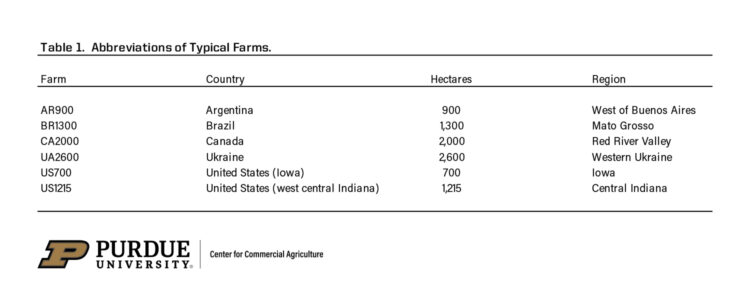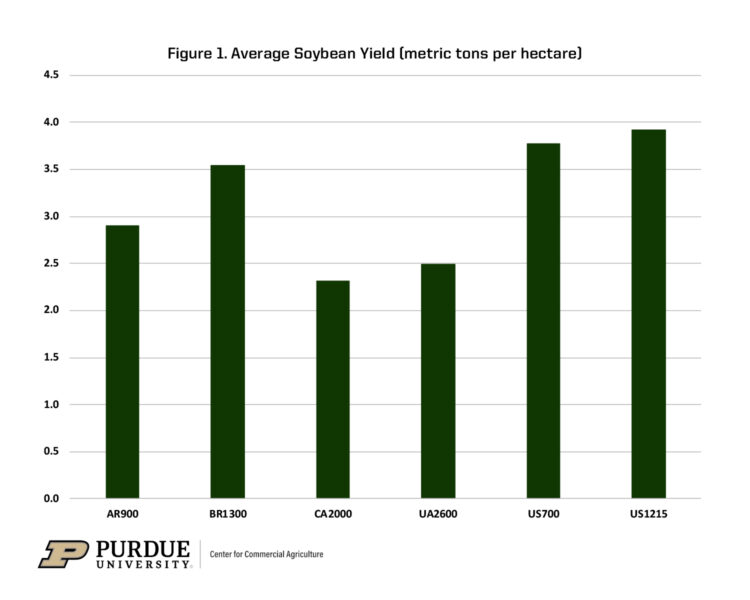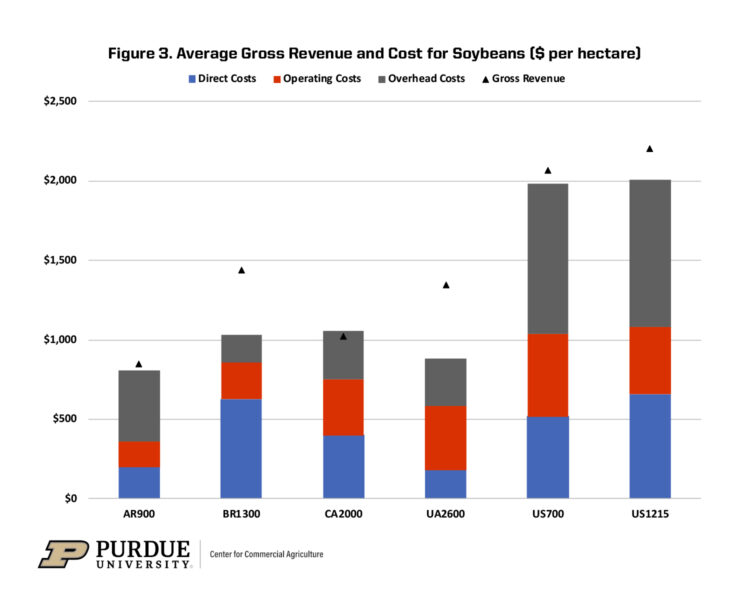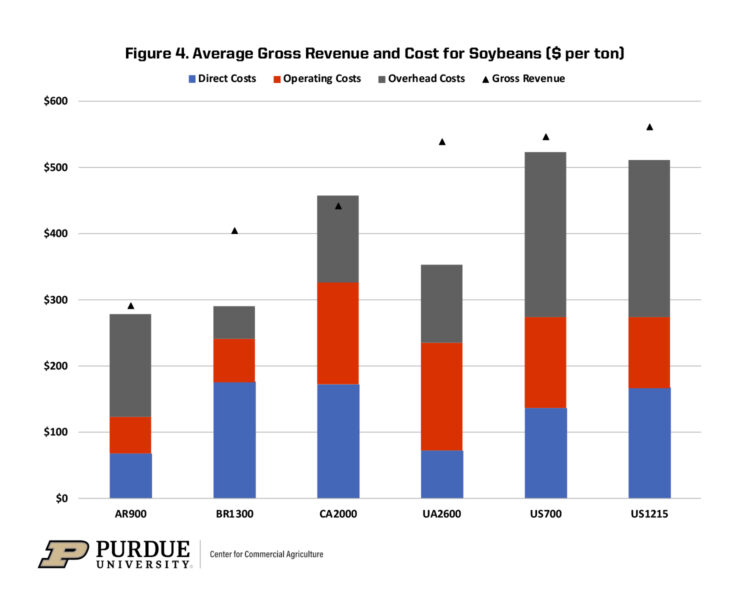March 6, 2024
International Benchmarks for Soybean Production (2024)
by Michael Langemeier
Examining the competitiveness of soybean production in different regions of the world is often difficult due to lack of comparable data and agreement regarding what needs to be measured. To be useful, international data needs to be expressed in common production units and converted to a common currency. Also, production and cost measures need to be consistently defined across production regions or farms.
This paper examines the competitiveness of soybean production for important international soybean regions using 2018 to 2022 data from the agri benchmark network. An earlier paper examined international benchmarks for the 2015 to 2019 period (Langemeier, 2021). The agri benchmark network collects data on beef, cash crops, dairy, pigs and poultry, horticulture, and organic products. There were 20 countries with corn, soybean, and/or wheat enterprise data for 2022 represented in the cash crop network. The agri benchmark concept of typical farms was developed to understand and compare current farm production systems around the world. Participant countries follow a standard procedure to create typical farms that are representative of national farm output shares, and categorized by production system or combination of enterprises and structural features. Costs and revenues are converted to U.S. dollars so that comparisons can be readily made. Data from six typical farms with soybean enterprise data from Argentina, Brazil, Canada, Ukraine, and United States were used in this paper. It is important to note that soybean enterprise data is collected from other countries. These five countries were selected to simplify the illustration and discussion.
The farm and country abbreviations used in this paper are listed in table 1. While the farms may produce a variety of crops, this paper only considers soybean production. Typical farms used in the agri benchmark network are defined using country initials and hectares on the farm. To fully understand the relative importance of the soybean enterprise on each typical farm, it is useful to note all of the crops produced. The typical farm in Argentina produced corn, sweet corn, soybeans, sunflowers, and winter wheat in 2022. Soybeans were produced on approximately 34 percent of the typical farm’s acreage during the five-year period. The typical farm in Brazil produced corn and soybeans in 2022. Soybeans were the first crop planted on all of the typical farm’s acreage during the five-year period. The farm in Canada produced corn, summer rapeseed, soybeans, and summer wheat in 2022. Soybeans were produced on approximately 33 percent of the typical farm’s acreage during the five-year period. Crops produced on the farm in the Ukraine in 2022 included corn, winter rapeseed, soybeans, sunflowers, and winter wheat. Soybeans were produced on approximately 66 percent of the typical farm’s acreage during the five-year period. There are four U.S. farms with soybeans in the network. The two farms used to illustrate soybean production in this paper are the Iowa typical farm (US700) and the west central Indiana typical farm (US1215). Both of these farms utilize a corn/soybean rotation.
Soybean Yields
Although yield is only a partial gauge of performance, it reflects the available production technology across farms. Average soybean yield for the farms in 2018 to 2022 was 3.16 metric tons per hectare (47.0 bushels per acre). Average farm yields ranged from approximately 2.31 metric tons per hectare for the typical farm in Canada (34.4 bushels per acre) to 3.92 metric tons per hectare for the typical farm in Indiana (58.3 bushels per acre). Figure 1 illustrates average soybean yield for each typical farm. Both of the U.S. farms had average soybean yields above 3.75 metric tons per hectare (55.8 bushels per acre).
Input Cost Shares
Due to differences in technology adoption, input prices, fertility levels, efficiency of farm operators, trade policy restrictions, exchange rate effects, and labor and capital market constraints, input use varies across soybean farms. Figure 2 presents the average input cost shares for each farm. Cost shares were broken down into three major categories: direct costs, operating costs, and overhead costs. Direct costs included seed, fertilizer, crop protection, crop insurance, and interest on these cost items. Operating cost included labor, machinery depreciation and interest, fuel, and repairs. Overhead cost included land, building depreciation and interest, property taxes, general insurance, and miscellaneous cost.
The average input cost shares were 33.7 percent for direct cost, 28.3 percent for operating cost, and 38.0 percent for overhead cost. The typical farms in Brazil and Canada had above average cost shares for direct cost. Operating costs as a proportion of total costs were relatively higher in Canada and the Ukraine. Overhead costs as a proportion of total costs were relatively higher in Argentina and the United States. The relatively large cost share for overhead cost in the U.S. reflects our relatively high land cost.
Revenue & Cost
Figure 3 presents average gross revenue and cost for each typical farm. Gross revenue and cost are reported as U.S. dollars per hectare. It is obvious from figure 3 that gross revenue per hectare is substantially higher for the two U.S. farms. However, cost is also substantially higher for these two farms. All of the typical farms, with the exception of the farm in Canada, exhibited economic profit during the five-year period. Economic profit for the other farms ranged from $40 per hectare in Argentina to $462 per hectare for the Ukraine farm. Economic profit for the typical farm in Brazil was over two times the economic profit for the Indiana farm, the most profitable U.S. farm during the five-year period. The typical farms in Brazil and the Ukraine had economic profits in each of the study years. Examining individual years for the remaining farms, the typical farm in Argentina had an economic loss in 2018, 2019, and 2020; the typical farm in Canada had economic losses in 2018 and 2019; the typical farm profit in Iowa had economic losses 2018, 2019, and 2020; and the typical farm in Indiana had an economic loss in 2019.
All of the typical farms in table 1 also produced corn during the five-year period. For the typical farms in Brazil and the Ukraine, average soybean profits were higher than average corn profits during the five-year period. The largest difference in favor of soybeans occurred for the typical farm in Brazil (difference of $323 per hectare). The second largest difference was exhibited by the typical farm in the Ukraine ($133 per hectare difference). Average corn profits were $171 per hectare higher in Argentina, $437 per hectare higher in Canada, $233 per hectare higher in Iowa, and $9 per hectare higher in Indiana than soybean profits. On average, for the typical farms with corn and soybeans examined in this paper, corn profits were $66 per hectare higher than soybean profits.
Figure 4 presents average gross revenue and cost for soybeans on a per ton basis. Gross revenue per ton was relatively higher for the typical farm in the Ukraine and the two typical U.S. farms. However, the two U.S. typical farms also had relatively higher costs per ton. Economic profit for the five-year period was positive for all of the typical farms except for the typical farm in Canada.
Conclusions
This paper examined yield, gross revenue, and cost for farms in the agri benchmark network from Argentina, Brazil, Russia, the Ukraine, and the United States with soybean enterprise data. Yield, gross revenue, and cost were substantially higher for the U.S. farms. In general, the 2018 to 2022 period was a profitable period for soybean production with each of the typical farms, except for the typical farm in Canada, exhibiting a positive economic profit. The next article in this series will examine the relative profitability of wheat production during the same period for typical farms in the agri benchmark cash crop network.
References
agri benchmark. http://www.agribenchmark.org/home.html. Accessed on March 28, 2022.
Langemeier, M. “International Benchmarks for Soybean Production.” Center for Commercial Agriculture, Purdue University, June 30, 2021.
TAGS:
TEAM LINKS:
RELATED RESOURCES
UPCOMING EVENTS
December 1 & 8, 2025
Join Purdue Extension for a two-part workshop designed to help you gain a clearer understanding of tax planning essentials. The first session on December 1 will focus on the fundamentals of farm taxes, with particular emphasis on strategies that can be used in a low net income year. The second session on December 8 will focus on key tax strategies and will allow plenty of time for questions. Registration cost is only $20.
Read MoreDecember 15, 2025
This program provides in-depth coverage of agricultural and farm tax issues. In addition to covering timely tax issues, we will cover disaster tax issues, depreciation and expensing farm assets, retirement planning for farms, and tax planning in low-income years. This year’s webinar will be co-taught by a team from Ohio State and Purdue Universities.
Read MoreJanuary 27 or 28, 2026
Farm Shield is more than a conference, it’s a commitment to helping agricultural families build resilience and plan for a secure future. Don’t miss this opportunity to protect your legacy!
Read More




